Automotive Robotics Market Size
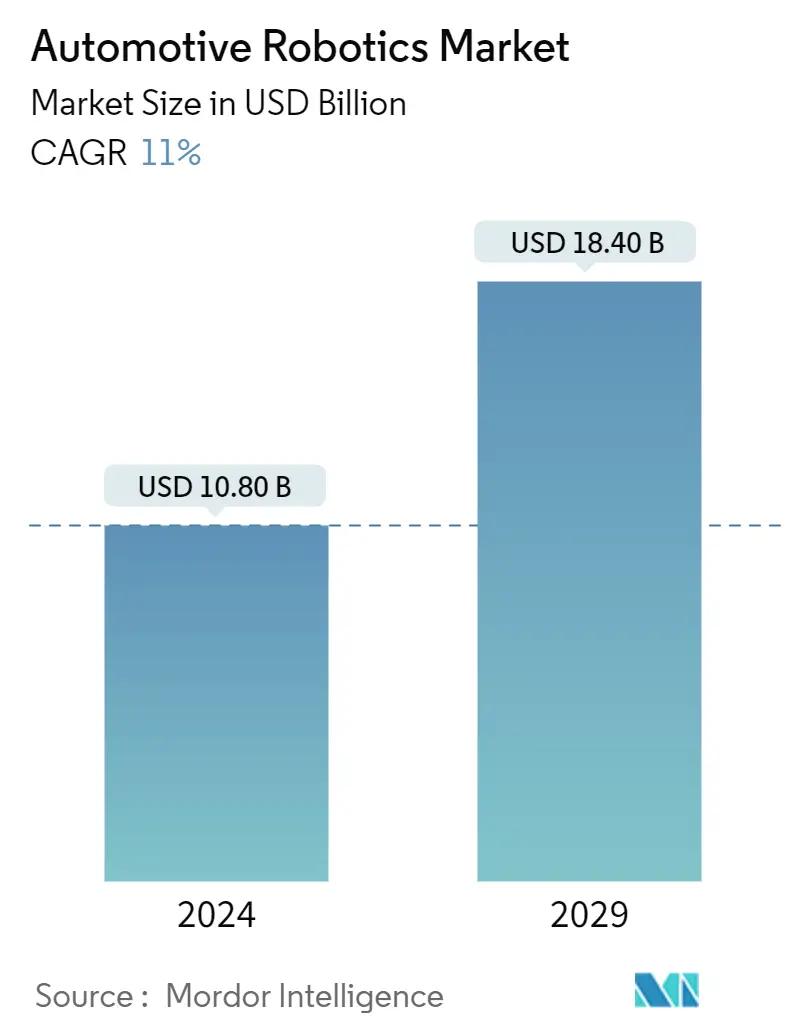
| Study Period | 2019 - 2029 |
| Market Size (2024) | USD 10.80 Billion |
| Market Size (2029) | USD 18.40 Billion |
| CAGR (2024 - 2029) | 11.00 % |
| Fastest Growing Market | North America |
| Largest Market | Asia Pacific |
Major Players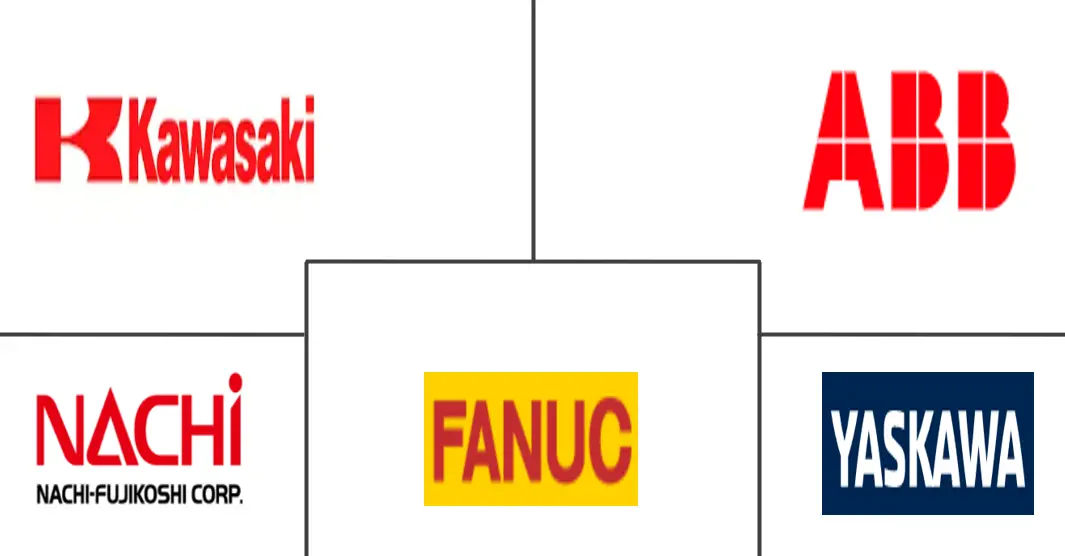
*Disclaimer: Major Players sorted in no particular order |
Automotive Robotics Market Analysis
The Automotive Robotics Market size is estimated at USD 10.80 billion in 2024, and is expected to reach USD 18.40 billion by 2029, growing at a CAGR of 11% during the forecast period (2024-2029).
Automotive robots are designed to support the production of automobiles in the automotive industry. This extraordinary growth of electric vehicles is positively inducing the use of robots to meet the market's growing consumer requirements. The automotive industry has been using industrial robotics in production for many years.
Articulated robots hold a large part of automotive robots; by function, welding makes the largest use of robots in the automotive industry. Robotic systems in the automotive industry are cost-effective, efficient, and safe, as they can do their job quicker than their human counterparts.
Several companies majorly focus on reducing costs, saving time, producing high-quality products, and increasing productivity with a minimum error rate in the automation industry, thus driving the market. In the production plant, automotive robots are deployed to automate internal processes to reduce the workload of employees by creating a work collaboration with the workers to improve efficiency. Companies such as Ford Motors Co. and BMW are working on introducing technology in their production plants.
For instance, in November 2023, Realtime Robotics announced the launch of its new Optimization-as-a-Service solution. The solution uses a combination of proprietary optimization software and experienced robotics and applies engineering insights to improve a manufacturer’s overall productivity. It has recently been used by Volkswagen Commercial Vehicles in Hanover, Germany, in a proof-of-concept project for EV manufacturing.
With the rising advancements in vehicle technologies and growing demand for electric vehicles, automotive robotics is expected to witness strong growth in the automotive industry for various robotic operations involved in the automobile production process. Considering the market potential, robotic manufacturers are working on launching various new models to cater to the high demand for robotics in the automotive industry.
For example, in June 2023, ABB announced the launch of four new large robot models and 22 variants to support automotive customers with next-generation models, including the IRB 6710, IRB 6720, IRB 6730, and IRB 6740.
North America is expected to grow significantly during the forecast period, followed by Europe and Asia-Pacific. Factors such as strategic collaborations among key players, growing vehicle production due to inflating disposable incomes in emerging economies, and rising investments in R&D activities for introducing energy-efficient automotive robots are creating a positive outlook for the market.
Automotive Robotics Market Trends
Welding Robots Hold the Highest Share
The automotive industry has adopted automotive robotics widely, with welding being one of the most prominent applications. Within the manufacturing environment, two types of welding robots are generally used, i.e., semiautomatic and automatic welding robot systems, for most welding operations in automotive manufacturing, which offer precision, efficiency, and speed.
These robots have increased factory safety and have helped save millions of dollars as they have the potential to double, or even triple, production time by cutting labor costs.
Considering the industry demands for lighter vehicles, robotic welders play an important role in producing advanced, top-tier vehicles. With strict industry standards, robots consistently prove their ability.
More companies are relying on robotic welding systems with technological advances for high-tech applications such as EV vehicles and self-driving cars, which require even more precise assembly.
For instance, in July 2023, Ficep UK launched a new automatic and robotic processing solution in response to market demand for a quality welding system to help address skilled labor shortages and increase productivity. In a new partnership with AGT Robotics, Ficep developed the Sabre welding robot to seamlessly tackle the most challenging and labor-intensive processes fabricators face in today’s structural steel fabrication market.
Robotics play an important part in manufacturing in many industries, with automotive being the dominating segment. Many companies expect technology to evolve with their needs.
For example, in January 2023, Oqton, a software provider of automation production solutions, and Valk Welding, a manufacturer of flexible arc welding robots, announced a new partnership. The new techniques and processes jointly developed by the companies are intended to enhance the utilization of automated robotic welding for unique or small-batch production.
The automotive industry is shifting its focus toward new technology trends, like compact robots and controllers, higher communication speed, low spatter, and high-speed welding. Thus, the welding segment is expected to hold the highest share.
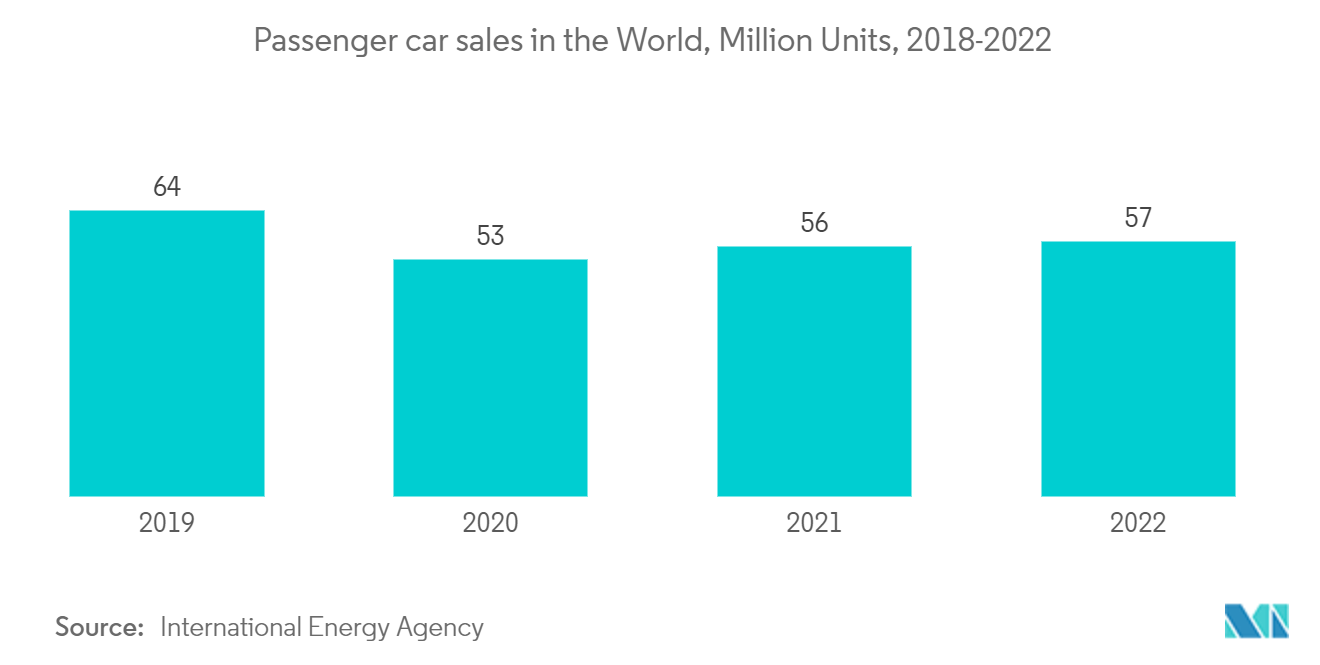
Asia-Pacific is Expected to Lead the Automotive Robotics Market
Robotics technology is increasingly being adopted in Asia-Pacific due to rising demand for the automation of processes, improved efficiency and productivity, and reduced human errors. Various sectors, including automotive, healthcare, defense, and aerospace, have adopted robotics technology for process automation and efficient resource management. Industrial robots are used mainly in Asia-Pacific due to their dominance in the automotive industry and low cost of manufacturing units. The automotive robotics market is expected to witness major growth during the forecast period due to the rapid expansion of small and medium-scale industries across Asia-Pacific.
Asia-Pacific is the fastest developing region globally, with countries like India, China, Taiwan, and South Korea evolving as the leaders in this region. Leading vendors, such as ABB and KUKA, are instituting the region as their operational bases. Government regulations and funds have empowered projects to improve the infrastructure. These aspects have made the region the favored automotive manufacturing hub, thus driving the automotive robotics market.
China and India are the principal countries in Asia-Pacific in terms of development, and many industries, such as automotive, electronics, and aviation, are opening their factories in these countries, thus generating the demand for automotive robotics and making Asia-Pacific an emerging region.
Major players in the region are adopting robotics and other advanced manufacturing technologies while also making huge investments in their upcoming vehicles. For instance, in November 2023, RSP tapped into India’s USD 13 billion robotics and automation market to start a manufacturing unit in 2024. The Indian entity Scandinavian Robot Systems India Private Limited has been registered in Chennai. It will supply a range of industrial robot accessories to Indian customers of various sectors, such as automotive and electronics.
In August 2023, Chinese automaker Geely Holding Group launched a premium intelligent technology brand, JI YUE, and unveiled its first high-tech model. The JI YUE 01, the results of a tie-up with Baidu Inc. on “automotive robotics,” will be produced by Geely.
Thus, owing to such developments in the region, Asia-Pacific holds the highest share.
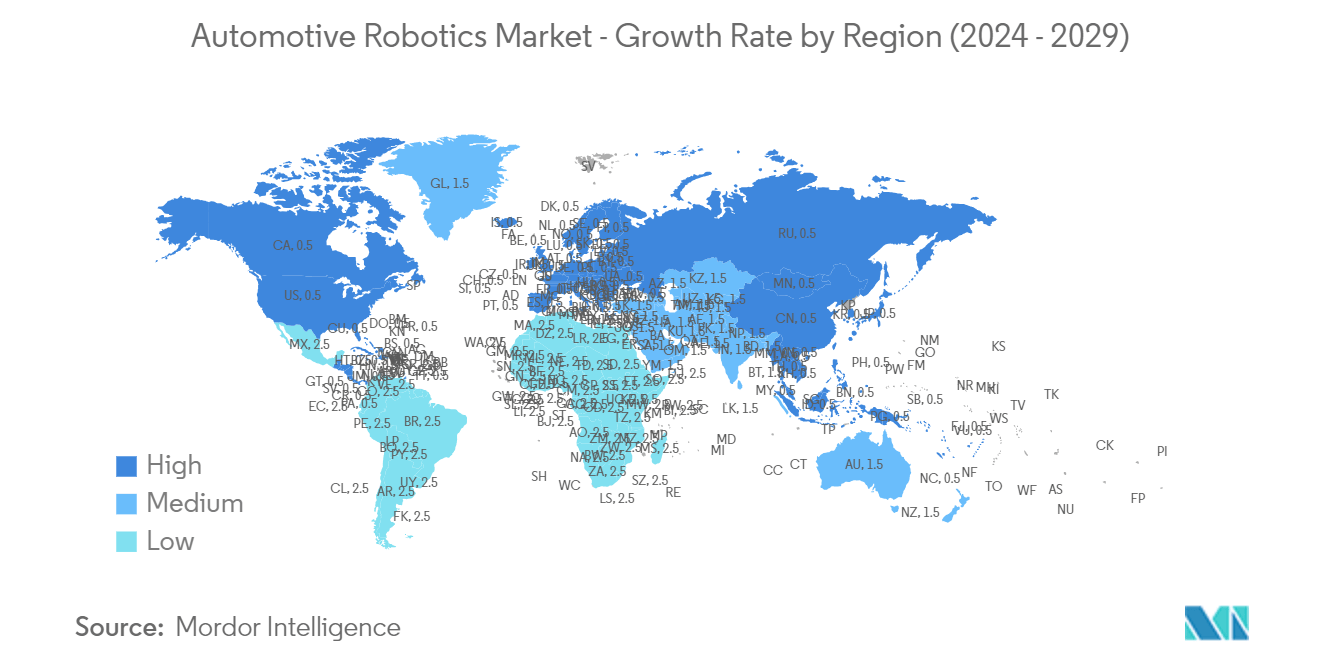
Automotive Robotics Industry Overview
The automotive robotics market is consolidated and led by globally and regionally established players. The companies adopt strategies such as new product launches, collaborations, and mergers to sustain their market positions.
- In August 2023, Horizon Robotics, a leading provider of energy-efficient computing solutions for advanced driver assistance systems (ADAS) in consumer vehicles, formed a strategic partnership with Aptiv PLC and its subsidiary Wind River in China. The collaboration marks Aptiv's first partnership with a Chinese domestic auto-grade computing solutions supplier for ADAS and automated driving.
Some of the major players in the market include Nachi-Fujikoshi Corp., ABB Ltd, FANUC Corporation, Kawasaki Robotics, and Yaskawa Electric Corporation.
Automotive Robotics Market Leaders
-
Nachi-Fujikoshi Corp.
-
ABB Ltd
-
FANUC CORPORATION
-
Kawasaki Robotics
-
Yaskawa Electric Corporation
*Disclaimer: Major Players sorted in no particular order
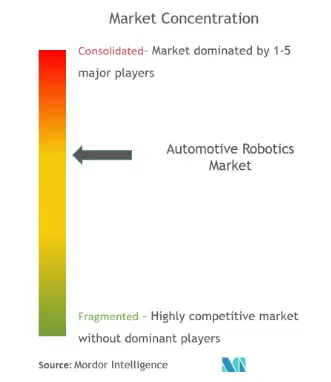
Automotive Robotics Market News
- September 2023: OTTO Motors announced the OTTO 1200, which it claimed is the highest-performing, heavy-duty mobile robot for compact environments. It can safely move payloads of up to 1,200 kg (2,650 lb). The autonomous mobile robot (AMR) is equipped with patented adaptive fieldset technology to quickly and safely maneuver around people in narrow spaces, as claimed by OTTO Motors.
- August 2023: AKia, in collaboration with Boston Dynamics, an American robotics company acquired by Kia’s parent company, Hyundai Motor Group, announced its plans to launch a new automotive robot in 2024.
- November 2023: ABB Robotics expanded its industrial SCARA robot portfolio with the addition of the IRB 930. The new robot, compromising three variants capable of handling 12 kg and 22 kg payloads, has been designed to meet the demands of new growth opportunities in traditional and new markets.
Automotive Robotics Market Report - Table of Contents
1. INTRODUCTION
- 1.1 Study Assumptions
- 1.2 Scope of the Study
2. RESEARCH METHODOLOGY
3. EXECUTIVE SUMMARY
4. MARKET DYNAMICS
-
4.1 Market Drivers
- 4.1.1 Exponential Increase in Automotive Sector
-
4.2 Market Restraints
- 4.2.1 High Cost of Installation Related to Industrial Robots
-
4.3 Industry Attractiveness - Porter's Five Forces Analysis
- 4.3.1 Threat of New Entrants
- 4.3.2 Bargaining Power of Buyers/Consumers
- 4.3.3 Bargaining Power of Suppliers
- 4.3.4 Threat of Substitute Products
- 4.3.5 Intensity of Competitive Rivalry
5. MARKET SEGMENTATION (Market Size in Value USD billion)
-
5.1 By End-user Type
- 5.1.1 Vehicle Manufacturers
- 5.1.2 Automotive Component Manufacturers
-
5.2 By Component Type
- 5.2.1 Controllers
- 5.2.2 Robotic Arms
- 5.2.3 End Effectors
- 5.2.4 Drive and Sensors
-
5.3 By Product Type
- 5.3.1 Cartesian Robots
- 5.3.2 SCARA Robots
- 5.3.3 Articulated Robots
- 5.3.4 Other Product Types
-
5.4 By Function Type
- 5.4.1 Welding Robots
- 5.4.2 Painting Robots
- 5.4.3 Assembling and Disassembling Robots
- 5.4.4 Cutting and Milling Robots
-
5.5 By Geography
- 5.5.1 North America
- 5.5.1.1 United States
- 5.5.1.2 Canada
- 5.5.1.3 Rest of North America
- 5.5.2 Europe
- 5.5.2.1 Germany
- 5.5.2.2 United Kingdom
- 5.5.2.3 France
- 5.5.2.4 Rest of Europe
- 5.5.3 Asia-Pacific
- 5.5.3.1 China
- 5.5.3.2 India
- 5.5.3.3 Japan
- 5.5.3.4 South Korea
- 5.5.3.5 Rest of Asia-Pacific
- 5.5.4 Rest of the World
- 5.5.4.1 South America
- 5.5.4.2 Middle East and Africa
6. COMPETITIVE LANDSCAPE
- 6.1 Vendor Market Share
-
6.2 Company Profiles*
- 6.2.1 ABB Ltd
- 6.2.2 Omron Adept Robotics
- 6.2.3 FANUC Corp.
- 6.2.4 Honda Motor Co. Ltd
- 6.2.5 Kawasaki Robotics
- 6.2.6 KUKA Robotics
- 6.2.7 Yaskawa Electric Corporation
- 6.2.8 Harmonic Drive System
- 6.2.9 RobCo S.W.A.T Ltd
- 6.2.10 Nachi-Fujikoshi Corp.
7. MARKET OPPORTUNITIES AND FUTURE TRENDS
** Subject To AvailablityAutomotive Robotics Industry Segmentation
Automotive companies use automotive robots for various tasks. The automotive robotics market is segmented by end-user, component, product, function, and geography.
By end-user type, the market is segmented into vehicle manufacturers and automotive component manufacturers. By component type, the market is segmented into controllers, robotic arms, end effectors, and drive and sensors. By product type, the market is segmented into Cartesian robots, SCARA robots, articulated robots, and other product types. By function type, the market is segmented into welding robots, painting robots, assembling and disassembling robots, and cutting and milling robots. By geography, the market is segmented into North America, Europe, Asia-Pacific, and Rest of the World. The report offers market size and forecasts for the automotive robots market in value (USD) and volume (units) for all the above segments.
| By End-user Type | Vehicle Manufacturers | |
| Automotive Component Manufacturers | ||
| By Component Type | Controllers | |
| Robotic Arms | ||
| End Effectors | ||
| Drive and Sensors | ||
| By Product Type | Cartesian Robots | |
| SCARA Robots | ||
| Articulated Robots | ||
| Other Product Types | ||
| By Function Type | Welding Robots | |
| Painting Robots | ||
| Assembling and Disassembling Robots | ||
| Cutting and Milling Robots | ||
| By Geography | North America | United States |
| Canada | ||
| Rest of North America | ||
| By Geography | Europe | Germany |
| United Kingdom | ||
| France | ||
| Rest of Europe | ||
| By Geography | Asia-Pacific | China |
| India | ||
| Japan | ||
| South Korea | ||
| Rest of Asia-Pacific | ||
| By Geography | Rest of the World | South America |
| Middle East and Africa |
Automotive Robotics Market Research FAQs
How big is the Automotive Robotics Market?
The Automotive Robotics Market size is expected to reach USD 10.80 billion in 2024 and grow at a CAGR of 11% to reach USD 18.40 billion by 2029.
What is the current Automotive Robotics Market size?
In 2024, the Automotive Robotics Market size is expected to reach USD 10.80 billion.
Who are the key players in Automotive Robotics Market?
Nachi-Fujikoshi Corp., ABB Ltd, FANUC CORPORATION, Kawasaki Robotics and Yaskawa Electric Corporation are the major companies operating in the Automotive Robotics Market.
Which is the fastest growing region in Automotive Robotics Market?
North America is estimated to grow at the highest CAGR over the forecast period (2024-2029).
Which region has the biggest share in Automotive Robotics Market?
In 2024, the Asia Pacific accounts for the largest market share in Automotive Robotics Market.
What years does this Automotive Robotics Market cover, and what was the market size in 2023?
In 2023, the Automotive Robotics Market size was estimated at USD 9.61 billion. The report covers the Automotive Robotics Market historical market size for years: 2019, 2020, 2021, 2022 and 2023. The report also forecasts the Automotive Robotics Market size for years: 2024, 2025, 2026, 2027, 2028 and 2029.
Automotive Robotics Industry Report
Statistics for the 2024 Automotive Robotics market share, size and revenue growth rate, created by Mordor Intelligence™ Industry Reports. Automotive Robotics analysis includes a market forecast outlook to 2029 and historical overview. Get a sample of this industry analysis as a free report PDF download.



